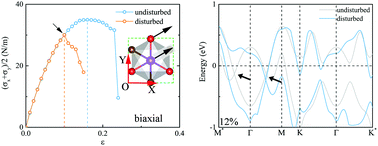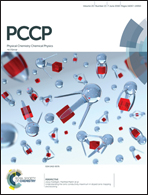Phonon-mediated stabilization and softening of 2D transition metal carbides: case studies of Ti2CO2 and Mo2CO2†
Abstract
Two-dimensional transition metal carbides (MXenes) exhibit excellent thermodynamic stability, mechanical strength and flexibility, which make them promising candidates in flexible devices and reinforcements in nanocomposites. However, the dynamic stability may intrinsically determine the preferred adsorption sites of functional groups in MXenes and lead to premature failure under finite strain before approaching the elastic limits. It is found interestingly that different adsorption sites of the functional groups correspond to the different phonon stabilities and adsorption energies of MXenes, which can be attributed to different hybridization characteristics between the metal-d and O-pz states and delocalized electron behaviors around the metal atoms. Although both Ti2CO2 and Mo2CO2 possess high ideal strengths and superior flexibility, the premature phonon instabilities appear unexpectedly in distinct manners before approaching their elastic limits. An in-depth exploration of the soft modes and deformed electronic structures reveals that a continuously decreasing gap-opening at the Γ point in Ti2CO2 increases after in-plane phonon instability due to the pseudo Jahn–Teller effect, differing from the out-of-plane phonon instability and semiconductor–metal transition under biaxial tension observed in MoS2. Although Mo2CO2 shows similar failure modes to graphene under uniaxial/biaxial tensions, the band crossings around the Fermi level are found to be responsible for its metallic character and elastic/phonon instabilities by modifying the elastic energy or electronic band energy, different from the gap opening appearing in graphene. Our results shed light onto the profound effect of the phonon instability on the preferable structure and strengths of MXenes, providing theoretical guidance on designing flexible MXene devices, raising a great challenge to the conventional strengthening theory by simply counting bonds.



 Please wait while we load your content...
Please wait while we load your content...